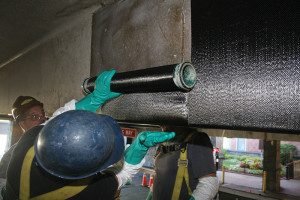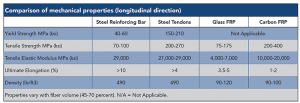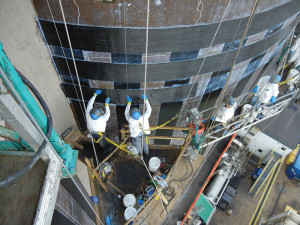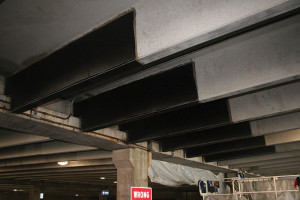Fiber-reinforced polymer (FRP) composites have been used for structural strengthening in the United States for almost 25 years. During this period, acceptance of FRP composites as a mainstream construction material has grown, and so has the number of completed FRP strengthening projects. As a result, the use of FRP for strengthening and retrofit is gaining more popularity among design professionals over conventional strengthening techniques, such as installation of supplemental structural steel frames and elements.
FRP strengthening of existing structures can involve complex evaluation, design, and detailing processes, requiring a good understanding of the existing structural conditions along with the materials used to repair the structure prior to FRP installation. The suitability of FRP for a strengthening project can be determined by understanding what FRP is and the advantages it offers, but more importantly, its limitations.
What is FRP Reinforcement?
FRP composite materials are comprised of high strength continuous fibers, such as glass, carbon, or steel wires, embedded in a polymer matrix. The fibers provide the main reinforcing elements while the polymer matrix (epoxy resins) acts as a binder, protects the fibers, and transfers loads to and between the fibers.
FRP composites can be manufactured on site using the wet lay-up process in which a dry fabric, made of carbon or glass, is impregnated with epoxy and bonded to prepared concrete substrate. Once cured, the FRP becomes an integral part of the structural element, acting as an externally bonded reinforcing system. FRP composites can also be prefabricated in a manufacturing facility in which the material is pultruded to create different shapes that can be used for strengthening applications, such as rods, bars and plates.
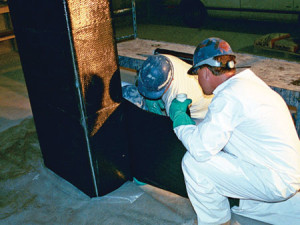
Wrapping FRP fabrics around columns increases the shear and axial strength to improve ductility and energy dissipation behavior.
The most common FRP systems for concrete strengthening applications are carbon fiber based (CFRP). Carbon has superior mechanical properties and higher tensile strength, stiffness, and durability compared with glass fiber based systems. The use of prefabricated CFRP bars and plates is typically limited to straight or slightly curved surfaces; for example, the top side or underside of slabs and beams. Prefabricated FRP elements are typically stiff and cannot be bent on site to wrap around columns or beams.
FRP fabric, on the other hand, is available in continuous unidirectional sheets supplied on rolls that can be easily tailored to fit any geometry and can be wrapped around almost any profile. FRP fabrics may be adhered to the tension side of structural members (e.g. slabs or beams) to provide additional tension reinforcement to increase flexural strength, wrapped around the webs of joists and beams to increase their shear strength, and wrapped around columns to increase their shear and axial strength and improve ductility and energy dissipation behavior.
The adhesive systems used to bond FRP to the concrete substrate may include a primer that is used penetrate the concrete substrate and improve bond of the system; epoxy putty to fill small surface voids in the substrate and provide a smooth surface to which the FRP system is bonded; saturating resin used to impregnate the fabric and bond it to the prepared substrate; and protective coating to safeguard the bonded FRP system from potentially damaging environmental and mechanical effects. Most epoxies for FRP strengthening systems are adversely affected by exposure to ultraviolet light, but can be protected using acrylic coatings, cementitious coatings, and other types of coatings.
The resins and fiber for a FRP system are usually developed as one system, based on materials and structural testing. Mixing or replacing a component of one FRP system with a component from another system is not acceptable and can adversely affect the properties of the cured system.
The bond between FRP system and the existing concrete is critical, and surface preparation is essential to most applications. Any existing deterioration or corrosion of internal reinforcement must be resolved prior to installation of the FRP system. Failure to do so can result in damage to the FRP system due to delamination of the concrete substrate.
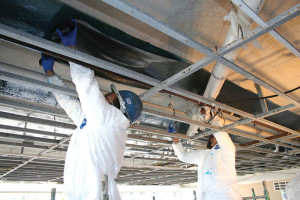
Additional tension reinforcement increases the flexural strength of slabs when FRP is adhered to the tension side.
Differences between FRP and Steel
FRP composites are different from steel in that they possess properties that can vary in different directions (anisotropic), whereas steel has similar properties in all directions (isotropic). The most common type of fiber sheets for concrete strengthening application are constructed with continuous unidirectional carbon or glass fiber that runs the length of the fabric. When loaded in direct tension, unidirectional FRP materials exhibit a linear-elastic stress-strain relationship until failure, with no yielding or plastic behavior. Due to the linear-elastic characteristics of FRP and the fact they are applied externally to structural elements, the standard methods used to design or determine the amount of steel reinforcement do not apply to FRP. Relatively more complex procedures are used to design FRP, which can involve iterative design methodology.
Because the fiber in an FRP material is the main load-carrying component, the type of fiber, orientation of fiber, and thickness of the fabric (quantity of fibers) dictate the tensile strength and stiffness.
FRP composites vary in strength depending on the type of fiber used. While glass provides a tensile strength nearly equal to mild steel yield strength, carbon composites provide a tensile strength that vary from twice to five times the yield strength of mild steel. While both FRP composites have tensile stiffness lower than that of steel, carbon composite stiffness is twice to five times the stiffness of glass composites. FRP composites have approximately one fifth the weight of steel.
The tensile properties of FRP strengthening systems can be obtained from the FRP system manufacturer. The tensile properties can also be determined using the test method described in ASTM D7565.
To account for material durability, most available design guides identify environmental reduction factors for the tensile strength of the FRP that can be used in design. These factors depend on the type of FRP and the exposure conditions for the element to be strengthened. For CFRP, the typical environmental reduction factor for interior exposure conditions is 0.95 while the reduction factor for exterior and aggressive exposure conditions is typically 0.85.
FRP Application
FRP systems provide a very practical tool for strengthening and retrofit of concrete structures, and are appropriate for:
- Flexural strengthening,
- Shear strengthening, and
- Column confinement and ductility improvement.
FRP systems have also been successfully used for seismic upgrading of concrete structures. These applications include mitigating brittle failure mechanisms such as shear failure of unconfined beam-column joints, shear failure of beams and/or columns, and lap splice failure. FRP systems have also been to confine columns to resist buckling of longitudinal steel bars. These FRP schemes increase the global displacement and energy dissipation capacities of the concrete structure, and improve its overall behavior.
Because of the resistance to corrosion, FRP composites can be utilized on interior and exterior structural members in all almost all types of environments.
Codes and Standards
There are several guides and codes published worldwide that address the design of externally bonded FRP reinforcement systems for concrete structures. In the United States, ACI Committee 440 has published ACI 440.2R, Guide for the Design and Construction of Externally Bonded FRP Systems for Strengthening Concrete Structures. However, this document is not considered a code and is not referenced in any code documents, including the International Building Code (IBC) and the International Existing Building Code (IEBC).
Understanding the need for a repair code, the American Concrete Institute (ACI) published, in 2013, Code Requirements for Evaluation, Repair and Rehabilitation of Concrete Buildings (ACI 562), which is the first performance-based standard developed for the repair of existing concrete buildings. This standard works with the IEBC where adopted, or as a stand-alone document for jurisdictions that have not adopted an existing building code.
The provisions in ACI 562 are not new to design professionals and include many of the same requirements as for the traditional design of concrete structures. ACI 562 directs design professionals to consider the behavior of the structure at all times during the repair process and after the repair is completed. ACI 562 permits the use of FRP materials for concrete repair and strengthening, and refers to ACI 440 standards for design and detailing requirements.
FRP Strengthening Limits
Minimum Existing Strength Limit
Per ACI 440.2R, in order for structural element to qualify for FRP strengthening, the existing structural member must maintain a certain minimum strength. This requirement is intended to guarantee that the ultimate capacity of the structural member without the FRP reinforcement is greater than a design force corresponding to the expected service loads under typical situations.
The minimum strength requirement in ACI 440.2R is:
Equation 1: [pmath]phi[/pmath]Rn = 1.1DL + 0.75LL
[pmath]phi[/pmath]Rn = design strength of the existing member without FRP
DL = new design dead load
LL = new design live load
This limit stipulates that externally bonded FRP reinforcement should be considered as secondary reinforcement and used to supplement the existing interior steel reinforcement. Should the FRP reinforcement be compromised, the structure must maintain sufficient capacity to carry existing service loads without collapse.
Since FRP composites are designed to last for the service life of the structure, the impact of possible future renovations and modifications should be considered where the FRP is accidentally damaged. Such damage may not be observed immediately and the structure, or structural component, may remain in service until the damage is identified and the affected areas are repaired. Equation 1 is intended to address these situations.
The limit of Equation 1 is intended to minimize the possibility of collapse due to FRP failure or damage. In cases where the design live load has a high likelihood of being present for a sustained period of time (such as storage areas), a live load factor of 1.0 should be used instead of 0.75.
This limit is independent from fire rating requirements. It must be satisfied, even if fire protection is applied to the FRP system. The limit is applicable to all types of strength increase such as shear, flexure and axial strengthening, but it does not apply to extreme loading events (seismic events, blast loading or other loads classified by ASCE 7 as extreme events).
Depending on dead load to live load ratio, the strength increase using FRP that satisfies Equation 1 typically results in up to 40% increase in strength. If the strength increase is higher than 40%, other conventional strengthening options should be considered.
Concrete Strength Limit
The existing concrete substrate strength is an important parameter for bond-critical applications, such as flexure or shear strengthening. For FRP to develop and transfer the design stresses at the bond line, the concrete substrate should possess sufficient strength to transfer these stresses. And, in order for the concrete to provide the minimum bond strength of 200 psi (1.4 MPa) specified by ACI 440.2R, the compressive strength of concrete f‘c must be more than 2500 psi (17 MPa). This limit does not apply for contact-critical applications like FRP column confinement which relies solely on contact between the FRP system and the concrete.
Fire Rating and Protection
While carbon fibers are capable of resisting high temperatures, adhesive systems have a much lower threshold temperature. Fireproofing of the FRP is an option, but the high costs for specialized fireproofing material aren’t always justifiable.
The fire rating of strengthened structures should be evaluated without FRP. A determination needs to be made as to whether or not the reduced strength is sufficient if the FRP fails. If it is, there is no need in fireproofing the FRP. If it is not, fireproofing materials should be evaluated for cost efficiency and the ability to meet satisfactory fire ratings.
Installation
Procedures for installing FRP systems have been developed by the system manufacturers and may differ slightly. Temperature and surface moisture of concrete at the time of installation are the main parameters that affect the installation procedure and performance of FRP systems.
Surface preparation to create a bond between the FRP system and the existing concrete is critical. Any existing deterioration and corrosion of internal reinforcing must also be resolved prior to installation of the FRP system. Strengthening can only be applied after all corrosion problems have been determined and resolved following the appropriate procedures. Failure to do so can result in locking in contaminants, which may cause further deterioration and result in failure of the FRP system due to delamination of the concrete substrate.
The International Concrete Repair Institute provides several guidelines for selection, surface preparation, and installation of repair materials. Once installed, the curing of the FRP system depends on the time after installation and temperature during curing. Similarly, temperature extremes or fluctuations can retard or accelerate FRP curing time. The higher the temperature, the faster the system will cure – anywhere from one to three days. Several grades of resin are generally available through the system manufacturer to accommodate special situations.
Conclusion
FRP systems have been successfully used to strengthen buildings, bridges, silos, tanks, tunnels, and underground pipes. The higher cost of FRP materials is offset by reduced costs of labor, use of equipment, and downtime during installation, making them more cost-effective than traditional strengthening techniques.
While strengthening with FRP can involve complex processes, this system offers a number of advantages compared to conventional strengthening methods. Understanding the properties and limitations of FRP is important step in developing the right design solution and utilizing it for the right application.▪

